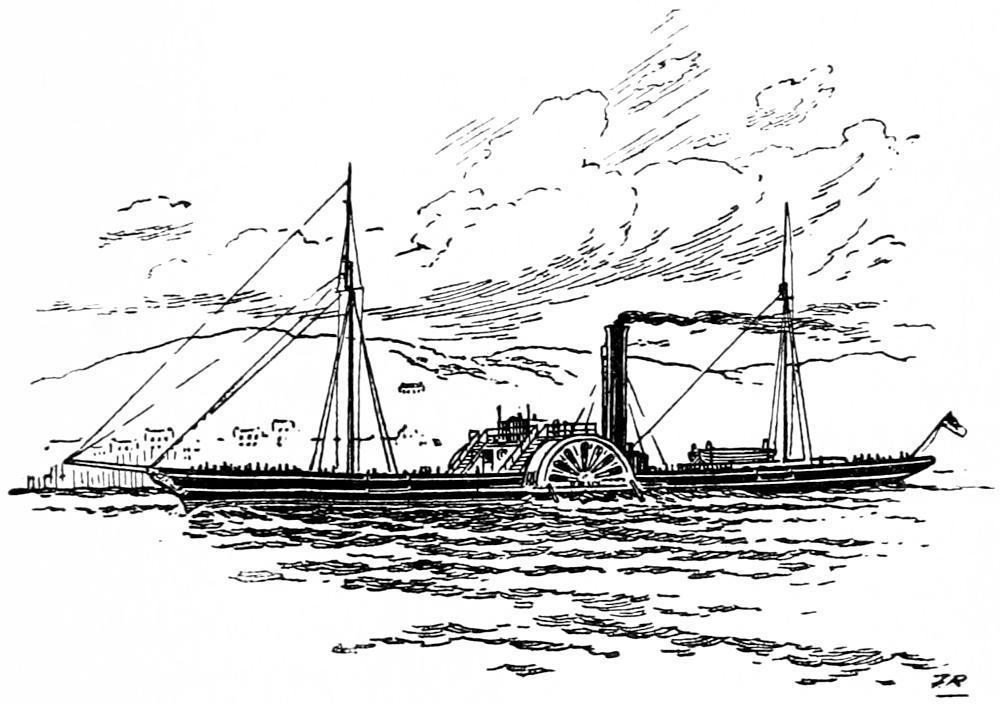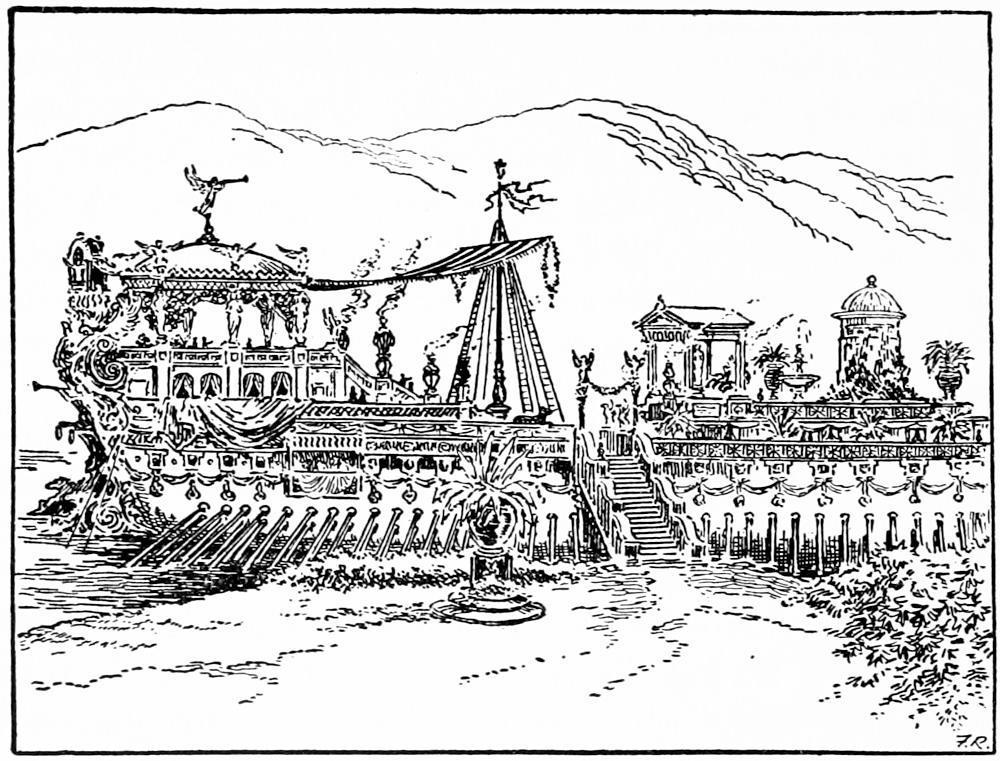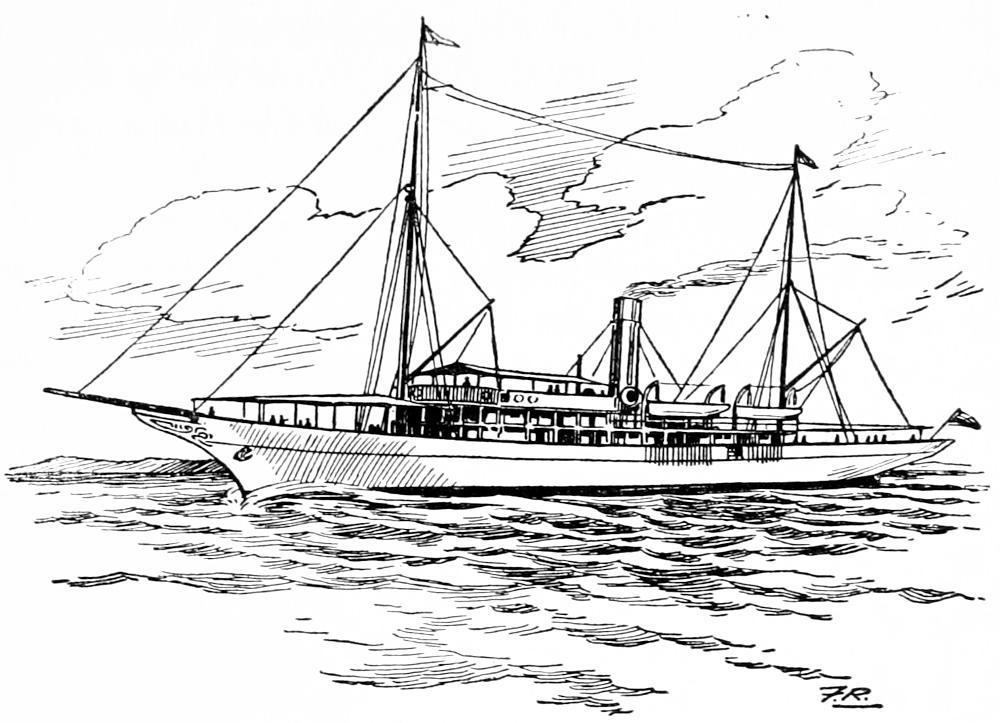Other documents randomly have different content
enlargement of several at the expense of the German lines that, during the preceding two decades, had thrust their way to the very forefront of the shipping world, only to lose it all by the terribly mistaken policies that they themselves had helped to foster.
In 1900 the two greatest steamship lines in the world were the Hamburg-American and the North German Lloyd. In 1910 they were surpassed only by a consolidation of seven British and American lines known as the International Mercantile Marine. Yet these two huge companies, at the close of the World War, were left with hardly more than a handful of ships each, all of their greatest liners, as well as most of their smaller ones, having been taken from them to sail under the British, American, French, and other flags.
Consequently, the greatest steamship company to-day—and it is so great as to have no close second—is the International Mercantile Marine, made up of the White Star, the Leyland, the American, and the Atlantic Transport lines, the Dominion and British North Atlantic Company, the National Steamship Company, and some other allied shipping interests.
This combination of shipping lines is controlled by British and American capital, but most of its ships sail under the British flag. American shipping laws are partly responsible for this, because of numerous restrictions they insist upon, which have proved to be detrimental to lines operating ships under the American flag. Other lines, entirely American owned, have been transferred to foreign register for the same reason.
Prior to the World War American deep-sea shipping had shrunk to a woeful degree, and most of America’s imports and exports were carried in foreign ships. The war, however, changed all that, and the United States, in a remarkably short time, had built ships enough to place it second only to Great Britain on the sea. Many of these ships were hurriedly and badly built, it is true, and many ridiculous experiments were tried out, but, despite mistakes, a great merchant fleet was built and put into operation. This, of course, was a war measure, but with the signing of the Armistice America set herself the task of operating this huge fleet. Post-war trade, however, did not
call for so many ships as were in operation, and vast fleets of ships were tied up to deteriorate in idleness. Not only America suffered. Great Britain, too, found herself with more ships than cargoes, and all over the world ships were tied up to wait for better times or to fall to pieces in the waiting.
This unfortunate condition, however, was not entirely without advantages. It forced economies in operation that resulted in increased efficiency, for ships could only continue to carry cargoes if they did so at low rates, and the shipping lines, therefore, studied every method by which they could reduce their costs of operation.
This, of course, brought about many rearrangements. Some formerly successful lines went bankrupt. Many new and inexperienced lines disappeared. Many masters and mates found themselves ashore without work, forced to take employment at whatever tasks they could get. But new lines did make their way, and most of the experienced lines managed to hold on, even going into new fields, as the practical elimination of the German lines gave them some opportunity to do. And following the war, American ships became known in ports where the American flag had not been seen for a generation or more.
This probably means that America is on the seas to stay No longer do internal developments take the attentions of the entire nation. The growth of manufacturing, the lack of wide public domains open to the “homesteader,” the widespread American interests overseas, all point to a permanent merchant marine, not, perhaps, so great as is Great Britain’s, because America is not so vitally dependent on the sea as is Great Britain, but great because America is great, and growing because America is still developing.
In this development shipping lines are the vital factors. Individual ships are merely pawns on a world-wide chessboard. A single ship can do nothing in the complex structure of modern commerce. Lines must maintain regular service They must maintain home and foreign offices. They must know where cargoes are to be had and where they are to go. They must have armies of agents and brokers constantly in touch with them. Their ships must be able to voyage
and return, voyage and return again, always filled, never idle, never at a loss for cargoes, else their costly structures will crumble, their finances wane, and they will find themselves faced with bankruptcy, disruption, reorganization or destruction.
Because of world economics shipping lines find it possible to develop or find themselves broken. Because the margin between success and failure is usually a narrow one shipping lines find it essential to seize upon every development that increases efficiency and decreases cost. Simple steam engines became compound, because shipping lines had to operate their ships with a smaller outlay for fuel in order to compete with sail. Iron gave way to steel, because greater strength was thus secured with less weight. The turbine has made its way against the reciprocating engine because of its increased efficiency and its consequent saving in expense. Oil is being more and more widely burned instead of coal, because its efficiency makes it cheaper through the use of fewer men, through increased steaming ability and less weight, as well as its cleanliness (on passenger ships) and the reduction in time used in coaling.
Shipping lines are very similar to railroads. A railroad train would be of no use to any one if it were owned and operated as a unit, even though it had all the tracks in a nation at its disposal. The train is practical only because the railroad company maintains freight and passenger stations, foreign and domestic agents, and all the detailed force that a modern railroad requires. Furthermore, it sends its trains over certain routes at certain specified intervals, ready to move freight and passengers as they are ready to be moved. So must a shipping line be operated. Ships must be where they are needed, else freight accumulates or is diverted to other lines. The huge investments ships require necessitate that there be no loss of time and consequently ships must not wait for freight to come to them. Because ships carry great amounts of freight and cannot lengthen or shorten themselves, as trains can, to accommodate fluctuating quantities, it is often necessary for freight to go in “tramp” steamers to ports which attract small amounts of freight. But cargoes must be waiting at those ports for shipment to some other or the ship loses time and the line loses money. Because of this agents are for ever
busy, cablegrams are for ever being flashed through the ocean depths, or ships are diverted by wireless in order to take advantage of temporary conditions.
These are the duties of shipping lines, and the vast companies of the modern world of the sea are amazingly capable, brilliantly alert, for ever in touch with shifting channels of trade, alert to fill the needs of a busy world that pays them only for the service it demands.
Perhaps the fierce competition of to-day seems harsh, yet it is constructive. Perhaps it bears too heavily upon many deserving individuals, yet through it has come about the vast improvement that has marked the shipping world in the last hundred years—an improvement that has shortened voyages, limited the time between continents, reduced the very world until voyages around it are now almost commonplace summer holidays.
Without competition the old East India Company sent its ships from England to the East for 300 years, and served Britain little better at the end of that time than at the beginning. With competition the transatlantic voyage has been cut from forty days to little more than four. Giant ships plough every sea and offer their magnificence to every passenger who cares to pay the passage money. No longer do silks and spices fill the holds of the argosies of the deep. Iron ore or polished motor cars, bales of cotton or crates of textiles, toys or machinery, hides or shoes, lumber or furniture—it matters not. Given only a place of origin and another place overseas where buyers wish it delivered and ships there will be to carry it. There is not a single harbour between the eternal ice of the two polar seas that is not visited by ships. There is not a person of the billion and a half who inhabit the globe but is affected by them. The natives of Central Africa buy cotton goods made in England of cotton grown in Alabama. The Eskimos of the frozen north hunt for seals with guns made in Connecticut. Oil that gushes from the rocks of Transcaucasia is refined, and burned in motor cars as they roll along the Champs Élysées. Copper from the Andes is made into roofing for houses everywhere on earth. Toys made in Czechoslovakia or Japan fill the counters of the toy shops of Britain and America.
No longer do oceans divide the world. As shipping lines continue their development they cannot fail to weld the world into a vast economic unit, interdependent and friendly, useful to one another and to unnumbered generations of the future.
To-day we look back to the beginnings of the shipping lines and smile as we think of their trifling activities. In a hundred years they have grown from infancy to vigorous manhood, but their future will not be one of senility. Instead, as years go by, their growth will greatly continue, and a hundred years from now the point of view of our children’s children will probably be to the shipping lines of to-day what ours is to the lines of a hundred years ago.
CHAPTER XIV
THE IMPORTANCE OF SHIPS
SINCE time immemorial man has sailed the sea, yet is the sea but little known. To most of us it is an enigma, even though we may often have viewed its undulating surface from the deck chairs of ocean liners. But the ocean is not to be learned by idling passengers in deck chairs. One must play a part—no matter what—in the struggle to master it before one may feel acquainted with it. Nor even then may one become familiar, nor trust it over much. Sometimes it rages loud and long, and finally, worn out with the strain of raging, goes into a sort of restless doze, with occasional reawakenings of anger. Sometimes it hides beneath a mask of fog—quiet but untrustworthy, motionless but sulky—giving out no warnings of its dangers, and stubbornly interfering with those that man sends out. But these are not the moods most natural to the sea.
Its moods are generally genial. Sometimes it lies for days, untroubled by its storms, unhidden by its fogs. All day its surface twinkles in the sunlight or all night rocks the bright reflection of the moon. It winks and smiles and whispers to the sides of every passing ship. Its sounds are sibilant and liquid. Or it may be playful, leaping joyously in great blue surges, through which the sunlight gleams. Now and then, perhaps, a wave may pop an inquisitive crest a little above the rail, and sprinkle sparkling drops of salty water over a sailor or a passenger, but one need only look down beside the ship and see the colour of the waves to know that therein lies only virile playfulness.
And these are the more usual of the moods of the sea. Now and then it turns gray with anger and flings itself about in fits of fuming rage. Now and then it glowers beneath the fog, ugly and menacing. But in that, as in its sunny gentleness and boisterous fun, it has only the attributes of many a child—quick to foolish anger, quick to sullen
sulking, but just as quick to gentleness and fun, and much more given to them.
But the sea, unfortunately, is generally judged by its moments of petulance. It is generally the story dealing with storm or fog that finds its way into the papers. In that we react toward the sea just as we do toward our neighbours’ children. Weeks may pass during which they are guiltless of a single childish prank and we are likely not to think of them at all. But let them tie a tin can to our old dog’s tail or run our cat high up among the branches of a tree, and we are likely to be loud in criticism of them.
And so the sea. It periodically, so to speak, ties tin cans to the tails of even the biggest ships. It sometimes drives badly treated vessels into the protecting reaches of our harbours. But for every traveller who has seen a storm at sea there are a hundred who never saw one, albeit many of these latter, because the ship may have rolled a bit too much to suit their untrained stomachs, would swear that they had passed through storms of the very greatest magnitude.
But storms, by and large, are not so serious as landsmen sometimes think. This is proved by the numerous long ocean voyages that have been made—that are constantly being made, as a matter of fact—by small ships, by yachts, by tiny sailboats, even by open rowboats, all over the world, and often for pleasure.
In 1896 two young Americans left New York in a small light rowboat, without sails or engine, and sixty-two days later landed at Havre, France, having rowed the entire distance—aided, of course, by the Gulf Stream Drift and by the fact that the prevailing winds were from astern. Such a trip is foolhardy in the extreme and proves nothing except that there are people foolish enough to do even so nonsensical a thing.
THE SPRAY
In which Captain Joshua Slocum circumnavigated the globe.
In 1849 a 41-foot sailboat sailed from New Bedford for San Francisco—a 13,000-mile voyage around Cape Horn, the most notorious cape in the world—and in 226 days had arrived at her destination.
In 1877 a man and his wife sailed a 20-foot decked whaleboat from New Bedford to Penzance, England, in forty-nine days. In 1878 a certain Captain Andrews and his brother sailed from Boston to England in a boat only 15 feet 6 inches long. They made the crossing in forty-five days.
Captain Joshua Slocum is famous among small-boat sailors. He made a voyage of 5,000 miles from Brazil to the United States in a 33-foot decked dory built from material salvaged from a wrecked ship. Later he sailed alone around the world in the 37-foot yawl Spray, on a voyage that occupied three years and two months. Captain Voss, a Canadian, sailed 40,000 miles in a 40-foot Alaskan war canoe which he had decked and otherwise prepared for the voyage. In 1911 Captain Thomas Fleming Day and two companions sailed the 25-foot yawl Seabird from Providence, Rhode Island, to Gibraltar in thirty-seven days including a five-day stop at the Azores. In 1912 the same Captain Day, with another party, took the 35-foot motor cruiser Detroit from Detroit, Michigan, to St. Petersburg, Russia. In 1921 Alfred Loomis and some friends sailed a 28-foot yawl from New York to Panama. Nor have I listed more than a fraction of the small boats that have crossed wide stretches of open ocean. That such voyages are not so ridiculous as many people unacquainted with the sea believe is proved by the valuable services rendered by the British motor launches during the World War. These 60- and 80-foot motor boats patrolled the rough waters of the Irish and North seas and the English Channel throughout the long submarine campaign, and America, as I have said before, in 1917 and 1918, sent shoals of submarine chasers, each but 110 feet in length, across the Atlantic to England, Ireland, France, the Mediterranean, and even to the Arctic coast of Russia, all without the loss by shipwreck of a single vessel. Yet despite all this evidence that proves the seaworthiness of small vessels and proves, too, the essential kindliness of the sea, most people ashore think of long voyages in small boats as being foolhardy and suicidal.
Of course, many such voyages have been foolhardy, and some have been suicidal. But to the person who knows the sea and who knows boats such voyages need be neither the one nor the other. A properly designed and constructed small boat well handled is not likely to founder. When carelessness or lack of information enters into either the designing, the construction, or the operation of such a boat the result may be different, although the sea, being usually in kindly mood, allows many such to pass unscathed.
THE DETROIT
This 35-foot motorboat made the voyage from Detroit, Michigan, to St. Petersburg, Russia.
A RECONSTRUCTION OF ONE OF CALIGULA’S GALLEYS
This luxurious ship was built on Lake Nemi, Italy, during the reign of the Emperor Caligula (37-41 A. D.). It sank to the bottom at some unknown period, and has often been examined by divers, for it is still in a fair state of preservation. It is 250 feet long, and its equipment was of the most luxurious kind. Suggestions for its recovery have been made, and it is possible that the lake, which is a small one, may be drained in order to study this old ship and another one that is lying near it.
In 1922 A. Y Gowan sailed a 98-foot motor cruiser around the world. That the boat was not designed for such a voyage is proved by the fact that her gasolene capacity was not great enough to permit her to make the longer jumps between ports entirely under
her own power This necessitated tows, and for many a weary mile of the way she wallowed and jerked at the end of a towline. Yet this yacht, intended though she was for protected waters, made the voyage, although she must have been uncomfortable to a degree in rough weather. This voyage proves that with a little thought, in these days of weather reports and compiled data on prevailing winds and stormy seasons, a small vessel may lay her course so as to avoid the most serious bad weather—barring, of course, local storms that do, sometimes, attain great ferocity. It is well known, for instance, that during the summer months the North Atlantic is generally mild while during some of the winter months it grows exceptionally boisterous and ugly. Therefore the small boat that would cross it had best choose the summertime. Should Mr. Gowan’s little yacht ever find herself in the grip of a really serious North Atlantic winter gale she would run a most excellent chance of never seeing pleasant weather again. Yet, as I have said, a tiny rowboat crossed this very stretch of water in the summer of 1896.

A EUROPEAN SIDE-WHEELER
These steamers are often seen in European waters and are widely used as excursion boats.
All of this merely means that good judgment, based upon experience and compiled information, is about the most valuable bit of sea-going equipment that the deep-sea small-boat sailor can have. Nor does that apply only to small-boat sailors. Nor, again, is it always necessary for the sailor, merely because his boat is small, to feel that he must stay in port in heavy weather or founder if it come upon him while he is on the sea. Not by such a doctrine have the fishermen of Gloucester made for themselves the reputation that they have. Summer and winter they take their schooners out to the Grand Banks and live out the greatest storms that try those stormtossed waters. From the deck of a 50-foot Gloucester fisherman I have seen the seas tower high before her bow, seemingly about to
crush the craft, and have seen the mighty troughs, which, from the crests of the great seas, seemed abysmal in their depth, yet did the little vessel ride through them without so much as a splintered rail. These schooners come in loaded with fish and often encrusted with ice. It is true that their sails are sometimes split, their masts sometimes swept overboard. Yet is the fatality among such vessels light, despite the fact that they face most of the storms that blow each winter on the Banks.
Had it not been that small boats can safely sail the seas it is difficult to see how we ever could have arrived at the era of great ships. Ancient history tells us of ships that, at least until the prime of Greece and Rome, could not by any stretch of the imagination be called large. Yet the old ships of the Phœnicians sailed, even before the days of Greece, all over the Mediterranean, out into the Atlantic, as far north as the English Channel, at least, and on one occasion, around Africa. Then came Greece, and ships grew somewhat in size. Then Rome appeared, and ships grew larger still, although most of them still were small, as always. By the time of Caligula (3741 A. D.) Roman shipwrights had greatly increased the size of their large ships, as is proved by a ship now resting on the bottom of Lake Nemi in Italy.
During and following the Dark Ages ships had again become small, and only gradually did they enlarge. Even by the time of the Spanish Armada a ship of 1,000 tons was considered huge. Yet such ships, as I said, were considered very large, not more than a handful of the more than three hundred ships in the Armada and the British fleet opposing it approaching such a measurement, and hardly more than three or four exceeding it. Among the 197 British ships that opposed the Armada but seven were more than 600 tons.
A HUDSON RIVER STEAMER
The passenger steamers of the Hudson are large, speedy, and are capable of carrying thousand of excursionists.
Even at the beginning of the 19th Century ships of a thousand tons or more were rare, and the famous clipper ships of even a later period were smaller almost as often as they were larger. Yet did these ships speed on their way across the oceans in all weathers in their furtherance of trade.
Of the billion and a half people who inhabit the world to-day few indeed appreciate the huge importance of ships. As I pointed out in my opening chapter, the world as we know it could not exist without them. Even the far simpler world of the ancients required them, and the modern world depends on them far more.
In Great Britain there is a wide and real appreciation of the value of merchant shipping. But the fact that Britain is an island depending upon lands across the seas for the very food that gives it life makes the importance of ships more evident. Not only for that, of course, are ships vital to Great Britain. To buy food her people must manufacture goods to sell to foreign peoples. Does the manufacturer weave textiles? His raw materials come from the United States, from Egypt, from Australia and New Zealand. Does he manufacture tires? His raw materials must be bought in the East Indies and Egypt. Does he manufacture cutlery? His product, or at least much of it, must be sold in foreign markets in order that such foreign products as are not to be found in Britain may be purchased. Does he need oil? He must buy it from the Dutch East Indies, from Transcaucasia, from America. Do the people need sugar for their tea? It must come from Cuba or Jamaica. Does the country need copper? It may come from Peru or Michigan. Furs? From Canada. Wheat? Argentina, Canada, Australia, the United States, Russia. Coffee? Brazil or Java. Rice? Japan, the Philippines. Lumber? Canada. Paper? Canada or Scandinavia.
And for every cargo bought in foreign lands a cargo should be returned, else trade is unhealthy and will languish. Britain, to a large extent, imports raw products and food, and exports manufactured articles and coal. This the people know and deeply realize. The result is that Britain’s merchant fleet is the greatest the world has ever seen.
A STEAM YACHT
Unfortunately the type of yacht pictured here is less common than formerly. These are being replaced by yachts with less graceful lines, differing from this in many respects but perhaps most noticeably in having a perpendicular bow and no bowsprit.
But in the United States the vital importance of ships is not widely understood. During the last decade of the 19th Century and the first one of the 20th it might almost have been said that the subject was not understood at all. The World War corrected that somewhat, but even after that holocaust had forced the subject before the public and had created a condition that demanded ships, the subject was not more than superficially grasped. The result was that the nation that had suddenly leaped to a position in world shipping second only to Great Britain so lightly took its responsibilities that its great fleet of
ships was permitted to run down when an economic crisis made it impossible for them to find cargoes. Almost as important in this deterioration of the American Merchant Marine after the war were the backward laws and lack of interest on the part of the people.
But the United States is not so situated that the importance of ships can easily be appreciated. The people would not starve if there were no ships, for the nation’s own resources, seconded by those of Canada, would prevent such a calamity. The land has coal and steel, has copper and cotton and farm products. It could have enough sugar without going overseas. Its great area and diversity of climatic conditions produce, perhaps, more of the necessities of life than can be produced by any other single nation. Yet is it dependent upon ships. Without them the millions of automobiles would shortly stop running—for lack of rubber, from which to make tires and insulation. Without ships the vast wheat crop could only with difficulty be harvested—for lack of binder twine, which is made from Yucatan sisal.
These imports are vital and there are others equally so, besides thousands without which we could get along, but less comfortably Coffee and tea, spices, silk, diamonds (not merely for jewellery, which is unimportant, but for industry in which vast numbers of them are essential to many processes of manufacture), chocolate, fish (or at least most of them), many metals necessary to industry, ingredients for many important drugs and medicines, mahogany and other fine woods which are vital for more than furniture, and a thousand other things that now are a part of everyday life.
The high standards of living now commonly accepted by the people of the United States would be greatly lowered were it not for the ships that bring to its ports the products of foreign lands and take away the country’s excess food products and manufactured and raw materials bought by those foreign lands.
AN EXPERIMENT OF 1924
This ship, designed by a German, is propelled by the wind blowing against the two strange towers. These towers are rotated by a motor with the result that, according to the Magnus law, the pressure of the wind becomes greater on one side of each tower than on the other, thus tending to move the ship. It seems hardly likely, at the time this book goes to press, that this application of a formerly unused physical law will revolutionize the propulsion of ships.
Nor, as the World War showed Americans, is it wise to depend upon foreign nations to transport all their products to America and carry all America’s products away. To be healthy the nation should maintain its own cargo fleet, which, in turn, should provide itself with
terminal facilities not only at home but also abroad, in order that cargoes may be loaded and unloaded economically and without delay. America has passed the era in which the interior development of the nation utilized all the energies of its ambitious population. Already it has stepped into the field of foreign commerce in which it must now continue. Time was when the nation’s interests lay entirely at home, but that time is no longer. Increasingly will America’s exports be a factor in foreign markets, and upon this depends to an ever-growing extent the welfare of Americans. Time was when the land was the producer only of raw materials. Now it is one of the world’s greatest manufacturing nations, with an infinite number of products that cannot be consumed at home.
Ships, then, must become a growing interest of Americans, for upon ships, and largely upon their own ships, must they depend to maintain the standards of living that have made Americans the most fortunate of the peoples of the world.
Whether it be the citizen of New York or of San Francisco, of the mountain states or of the prairies—whether it be the clerk, the farmer, the manufacturer, or the ranchman—whether it be the millionaire or the day labourer, the teacher or the business man, still should he interest himself in ships, for only upon a wide appreciation of their value can wise legislation be built, and only with the support of the people can great fleets be maintained to carry the nation’s products to other lands and return with those vital cargoes upon which the nation’s comfort and happiness are so largely built.
THE END
Welcome to our website – the ideal destination for book lovers and knowledge seekers. With a mission to inspire endlessly, we offer a vast collection of books, ranging from classic literary works to specialized publications, self-development books, and children's literature. Each book is a new journey of discovery, expanding knowledge and enriching the soul of the reade
Our website is not just a platform for buying books, but a bridge connecting readers to the timeless values of culture and wisdom. With an elegant, user-friendly interface and an intelligent search system, we are committed to providing a quick and convenient shopping experience. Additionally, our special promotions and home delivery services ensure that you save time and fully enjoy the joy of reading.
Let us accompany you on the journey of exploring knowledge and personal growth!



















